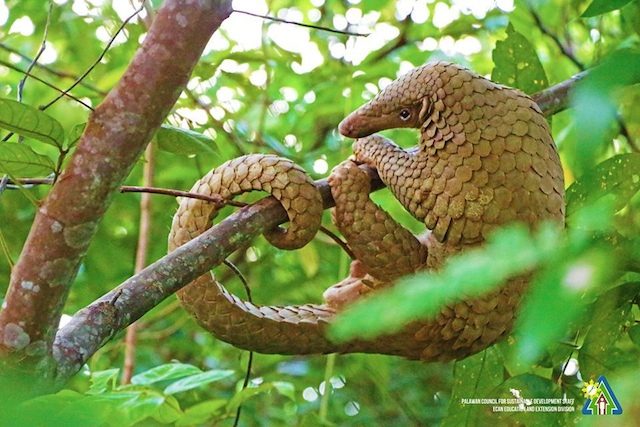SUMMARY
This is AI generated summarization, which may have errors. For context, always refer to the full article.

PALAWAN, Philippines – Whenever they hike through a vast, lush forest in Palawan, 25-year-old Jonhlee Pastrana and another wildlife research assistant usually have a GPS device and a satellite phone with them.
They also hike with an indigenous mountain guide who knows the place better, to make sure they won’t get lost as they scour through the mountains in hopes of spotting a good number of the elusive Philippine pangolin (Manis culionensis), which is now on the brink of extinction.
Lucrative pangolin trade
Considered as the least studied and only pangolin species endemic to a single country, Philippine pangolin is one of 8 pangolin species indigenous to Africa and Asia. It was originally listed as Malayan or Sunda pangolin (M. javanica) prior to being recognized as a distinct species in 1998.
Also known as Palawan pangolin, this scaly mammal is listed as critically endangered by the International Union for the Conservation of Nature (IUCN), an authority in evaluating the global conservation status of biological species.
In 2016, all the 8 pangolin species were uplisted to the highest category of protection under the Convention on International Trade in Endangered Species (CITES), making all commercial trade of wild-caught pangolins and their parts illegal.
Worldwide, more than one million pangolins are believed to have been snatched from the wild in the past decade alone, earning it the title as the “most heavily trafficked wild mammal in the world.”
Pangolin scales and meat are in high demand in Asian markets, specifically in China and Vietnam where they are primarily used as traditional medicine and served as a delicacy in luxury restaurants, respectively. The meat can fetch for $3 to $5 per kilo, while the scales can sell for $130 to $190 per kilo.
If killed to supply the lucrative trade, pangolins will cease to perform its supposed ecological role of regulating social insect populations. With their uncontrolled populations, they may turn into pests that could wreak havoc in local communities. Annually, an adult pangolin can consume more than 70 million insects such as ants and termites, a 2008 study noted.
Fast-declining population
Despite the attention given to Palawan as the country’s “last ecological frontier,” years of unabated pangolin poaching has continued, resulting in its fast-declining populations. Compounding the threat of illegal trade to Palawan pangolin is habitat loss driven by deforestation caused by slash-and-burn farming, charcoal making, and timber poaching.
“The presence of pangolin means Palawan’s forest habitats are still intact. If we lose this indicator species, Palawan, from being ‘the last frontier,’ could become ‘a lost frontier,'” Nelson Devanadera, executive director of the Palawan Council for Sustainable Development Staff (PCSDS), told a small group of journalists recently.
An IUCN 2014 assessment stated that Pangolin populations are suspected to have dropped by more than 50% over the past 20 years, based on available apprehension and illegal trade data.
Environmental lawyer Robert Chan stressed that the dwindling number of Palawan pangolin in the wild underscores PCSDS’ years of failure in fulfilling its mandate to implement the Wildlife Resources Conservation and Protection Act. PCSDS is an attached agency of the Department of Environment and Natural Resources.
“The [dire] status of pangolin is a microcosm of PCSDS’ ineptitude when it comes to [wildlife law] enforcement,” Chan, executive director of Palawan NGO Network Incorporated, told Rappler in a separate interview. He also claimed that the agency recently swore in over 100 wildlife protection officers “but none of these are visible in the forests when our para-enforcers go on patrol.”
In defense, Devanadera said ensuring the perpetuity of terrestrial wildlife species, including the pangolin, is “a very challenging job,” considering Palawan has almost 700,000 hectares of forest – the largest of all the Philippine provinces – that need to be patrolled. He also admitted that the illegal wildlife trade in the province is “very alarming.”
“The criminals are working faster than us. While we have the technology and intelligence at hand, they do much better because [at stake are their] business and survival. So I think we should think as criminals as well [to know] what’s in their mind,” Devanadera added.
From 2001 to 2017, 38 apprehensions within the Philippines yielded a total of 667 pangolins, based on the 2018 report of international wildlife trade monitoring group TRAFFIC.
The report, which included government and non-government confiscation data, noted that seizures increased from 2010 onwards, and peaked in 2012 and 2014.
“The poaching and trafficking of the Philippine pangolin is very alarming due to its relatively small geographic range and various threats, such as habitat loss, to its survival,” report co-author Emerson Sy told Rappler in an online interview.
“[If] we don’t act urgently now, we will lose the Philippine pangolin forever,” warned Sy, executive director of Philippine Center for Terrestrial and Aquatic Research.

Lack of scientific data
Palawan environment authorities admitted they have a hard time managing the remaining populations of the Palawan pangolin considering the scant scientific information available pointing to its exploitation rate and abundance in the wild.
“At the moment, there is no scientific study that would show the status of the pangolin species in the entire province,” PCSDS zoologist Levita Lagrada told Rappler in an email interview on June 1.
“There’s a lack of population data mainly because the species is elusive, solitary, and nocturnal,” noted Lagrada, who is also a member of the IUCN Pangolin Specialist Group.
In a bid to save Palawan pangolin from extinction, the United States Agency for International Development (USAID) Protect Wildlife project approved PCSDS’ proposal to fund a study that would assess the indicative presence and abundance of the Palawan pangolin in the Victoria-Anepahan Mountain Range (VAMR) in central-southern Palawan.
“We hope that the information generated by this research will contribute to strong, science-based recommendations – both in policy and action – for conserving the remaining strongholds of the Philippine pangolin,” USAID Protect Wildlife communications manager Lawrence San Diego said.
Ground survey, camera traps
Pastrana’s nonprofit group Katala Foundation Incorporated (KFI), which runs the Palawan Pangolin Conservation Program, is tasked to conduct ground survey and setup camera traps in several locations in the 510,502.66-hectare VAMR that straddles Puerto Princesa City, Aborlan, Narra, and Quezon towns.
The sites were the ones identified by the indigenous peoples interviewed by the Palawan State University researchers who are also key partners in the study. Included in the interviewees were former native hunters who supplied the pangolin trade.
Pastrana is assigned to do ground survey in 12 sites with a combined land area of 2,400 hectares. Each site spans 200 hectares, which is equivalent to the estimated habitat range of a solitary male pangolin.
His ordeal would start from 10 am to 5 pm. Throughout the 12-day mission in each site, he would scout around 17 hectares every day. It’s quite a challenging task but he needs to be patient to spot telltale signs of the presence of pangolin. These clues include burrows or scratches they make as they look for ants and termites that serve as their food. Decomposing trunks, termite, ant mounds, and nests are also possible indicators.
“When we find these signs we would mark the places and go back there at 11 pm when the nocturnal pangolins are awake and possibly roaming around the forest,” he told Rappler.
On a pitch-black night nothing can be heard except the deafening chorus of crickets. Carrying a flashlight they would return to the places they marked in hopes of spotting their shy target.
After minutes and sometimes hours of gazing around, the pangolin would finally show up. “Seeing at least one pangolin a night makes us happy. Since sighting the animal for the first time in the wild, we always look forward to nights we can see new ones again,” Pastrana shared.
To make sure they would not add to the count the same pangolin which they may encounter in the future, he would put a water-based paint marking on the animal’s body, and record its length and weight.
But they don’t see a pangolin every night. In fact, sometimes they would stay awake until 5 am and still not spot a single pangolin. Worse, there were times they saw nothing in their 12 days in the mountains.
“It saddens us,” Pastrana said. “If we spot none, we feel they are really vanishing.”
Meanwhile, wildlife researcher Shiela Mae Cetenta is tasked to install 33 camera traps that would help validate the reported sightings of pangolins in 5 plots of 3,300 hectares of forests across VAMR.
Born and raised on an island barangay up north, the 27-year-old lady was not used to mountaineering. In fact, that’s her first time to scale mountains. “It’s challenging because we don’t know if the terrain is flat or too steep and dangerous to climb. In high elevation, there are opportunistic, blood-sucking leeches. Rain or shine the mission continues,” Cetenta told Rappler.
Each camera trap weighs two kilos, thanks to their two indigenous mountain guides who also serve as their porters. “We would go to areas where trees and water are abundant, because it’s in that kind of environment [that] most of the wildlife thrive, including pangolins,” she added.
Cetenta’s team would fasten the camera trap at least knee-high on the tree trunk in an area where signs of pangolin’s occurrence are evident. She would make sure no objects could block the camera sensor to capture photos of the said animal.
“We would leave the 33 camera traps in one plot and then retrieve them after 45 days. The camera traps will be transferred to the other plots,” she said.
Since the yearlong research activities began in September 2018, the ground survey in 9 out of 12 plots recorded 14 pangolins, two of which are pregnant. The camera traps captured 7, bringing the total number to 21 so far. “We are lucky to have that, considering its population is declining fast,” said KFI PCCP coordinator Glesselle Batin.
Cetenta said the initial results are heart-crushing, but all hope is not lost. “I’m a bit dismayed because it didn’t exceed my personal expectation of at least 1 pangolin per camera. Nonetheless, I’m still hoping to see more in our two remaining sites in Quezon and Puerto Princesa City,” she added.
Aside from pangolins, the camera traps also captured photos of other rare animal species, such as the Palawan-endemic stink badger, porcupine, and peacock pheasant, among others.
Critical habitat declaration
In April 2018, the conservation community gathered in Puerto Princesa City to craft a 25-year roadmap to safeguard the future of the Palawan pangolin. Part of the action plan is to declare some forested areas as critical habitats after determining the population distribution of pangolins in the province.
Under the Philippine’s Wildife Resources Conservation and Protection Act, critical habitats enjoy an added layer of protection from destructive human activities, including logging, forest conversion to agriculture and settlements, and mineral exploration and extraction, among others that drive habitat loss. These are punishable by imprisonment of up to 8 years and a fine of up to P5 million.
With the research publication by the end of 2019, Lagrada said it will serve as “a tool to identify the strongholds of pangolin population” where more focused conservation efforts could be channeled.
“The study’s expected outcome is for pangolin habitats to be declared as protected and co-managed with the indigenous communities. Once habitats are identified and protected, we can prevent its population decline, and at the same time strengthen wildlife law enforcement,” she added. – Rappler.com
This article is produced through a USAID Protect Wildlife-sponsored media tour for a small group of journalists on May 22-23.
Add a comment
How does this make you feel?
There are no comments yet. Add your comment to start the conversation.